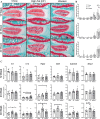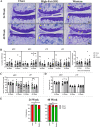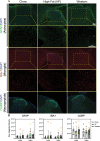Diet-induced obesity leads to behavioral indicators of pain preceding structural joint damage in wild-type mice
- PMID: 33752736
- PMCID: PMC7983381
- DOI: 10.1186/s13075-021-02463-5
Diet-induced obesity leads to behavioral indicators of pain preceding structural joint damage in wild-type mice
Abstract
Introduction: Obesity is one of the largest modifiable risk factors for the development of musculoskeletal diseases, including intervertebral disc (IVD) degeneration and back pain. Despite the clinical association, no studies have directly assessed whether diet-induced obesity accelerates IVD degeneration, back pain, or investigated the biological mediators underlying this association. In this study, we examine the effects of chronic consumption of a high-fat or high-fat/high-sugar (western) diet on the IVD, knee joint, and pain-associated outcomes.
Methods: Male C57BL/6N mice were randomized into one of three diet groups (chow control; high-fat; high-fat, high-sugar western diet) at 10 weeks of age and remained on the diet for 12, 24, or 40 weeks. At endpoint, animals were assessed for behavioral indicators of pain, joint tissues were collected for histological and molecular analysis, serum was collected to assess for markers of systemic inflammation, and IBA-1, GFAP, and CGRP were measured in spinal cords by immunohistochemistry.
Results: Animals fed obesogenic (high-fat or western) diets showed behavioral indicators of pain beginning at 12 weeks and persisting up to 40 weeks of diet consumption. Histological indicators of moderate joint degeneration were detected in the IVD and knee following 40 weeks on the experimental diets. Mice fed the obesogenic diets showed synovitis, increased intradiscal expression of inflammatory cytokines and circulating levels of MCP-1 compared to control. Linear regression modeling demonstrated that age and diet were both significant predictors of most pain-related behavioral outcomes, but not histopathological joint degeneration. Synovitis was associated with alterations in spontaneous activity.
Conclusion: Diet-induced obesity accelerates IVD degeneration and knee OA in mice; however, pain-related behaviors precede and are independent of histopathological structural damage. These findings contribute to understanding the source of obesity-related back pain and the contribution of structural IVD degeneration.
Keywords: Behavioral measures of pain; High-fat diet; Intervertebral disc degeneration; Obesity; Osteoarthritis; Western diet.
Conflict of interest statement
The authors declare no competing interests.
Figures







Similar articles
-
Impact of age on host responses to diet-induced obesity: Development of joint damage and metabolic set points.J Sport Health Sci. 2020 Mar;9(2):132-139. doi: 10.1016/j.jshs.2019.06.004. Epub 2019 Jun 15. J Sport Health Sci. 2020. PMID: 32099721 Free PMC article.
-
Leptin and the intervertebral disc: a biochemical link exists between obesity, intervertebral disc degeneration and low back pain-an in vitro study in a bovine model.Eur Spine J. 2019 Feb;28(2):214-223. doi: 10.1007/s00586-018-5778-7. Epub 2018 Oct 15. Eur Spine J. 2019. PMID: 30324498
-
Leptin signaling and the intervertebral disc: Sex dependent effects of leptin receptor deficiency and Western diet on the spine in a type 2 diabetes mouse model.PLoS One. 2020 May 6;15(5):e0227527. doi: 10.1371/journal.pone.0227527. eCollection 2020. PLoS One. 2020. PMID: 32374776 Free PMC article.
-
The pathogenesis of degeneration of the intervertebral disc and emerging therapies in the management of back pain.J Bone Joint Surg Br. 2012 Oct;94(10):1298-304. doi: 10.1302/0301-620X.94B10.28986. J Bone Joint Surg Br. 2012. PMID: 23015552 Review.
-
A new immunometabolic perspective of intervertebral disc degeneration.Nat Rev Rheumatol. 2022 Jan;18(1):47-60. doi: 10.1038/s41584-021-00713-z. Epub 2021 Nov 29. Nat Rev Rheumatol. 2022. PMID: 34845360 Review.
Cited by
-
Comparative histopathological analysis of age-associated intervertebral disc degeneration in CD-1 and C57BL/6 mice: Anatomical and sex-based differences.JOR Spine. 2023 Dec 3;6(4):e1298. doi: 10.1002/jsp2.1298. eCollection 2023 Dec. JOR Spine. 2023. PMID: 38156059 Free PMC article.
-
Lipid metabolic disorders and their impact on cartilage endplate and nucleus pulposus function in intervertebral disk degeneration.Front Nutr. 2025 Mar 10;12:1533264. doi: 10.3389/fnut.2025.1533264. eCollection 2025. Front Nutr. 2025. PMID: 40129665 Free PMC article. Review.
-
iNOS Mediates High-Fat Diet-Associated Aggravation of Complete Freund's Adjuvant-Induced Inflammatory Pain.Int J Mol Sci. 2025 Jun 5;26(11):5422. doi: 10.3390/ijms26115422. Int J Mol Sci. 2025. PMID: 40508229 Free PMC article.
-
Activation of LAMP1-mediated lipophagy by sulforaphane inhibits cellular senescence and intervertebral disc degeneration.J Orthop Translat. 2025 Jun 2;53:12-25. doi: 10.1016/j.jot.2025.05.010. eCollection 2025 Jul. J Orthop Translat. 2025. PMID: 40525097 Free PMC article.
-
Molecular-Morphological Relationships of the Scaffold Protein FKBP51 and Inflammatory Processes in Knee Osteoarthritis.Cells. 2021 Aug 25;10(9):2196. doi: 10.3390/cells10092196. Cells. 2021. PMID: 34571845 Free PMC article.
References
-
- Blüher M. Obesity: global epidemiology and pathogenesis. Nat Rev Endocrinol. 2019;15(5):288-98. - PubMed
-
- Taylor VH, Forhan M, Vigod SN, McIntyre RS, Morrison KM. The impact of obesity on quality of life. Best Pract Res. 2013;27(2):139-46. - PubMed
-
- Shiri R, Karppinen J, Leino-Arjas P, Solovieva S, Viikari-Juntura E. The association between obesity and low back pain: a meta-analysis. Am J Epidemiol. 2010;171(2):135–54. - PubMed
Publication types
MeSH terms
Substances
Grants and funding
LinkOut - more resources
Full Text Sources
Other Literature Sources
Research Materials
Miscellaneous

